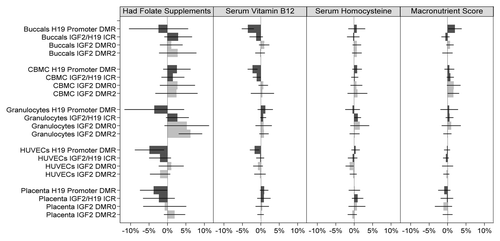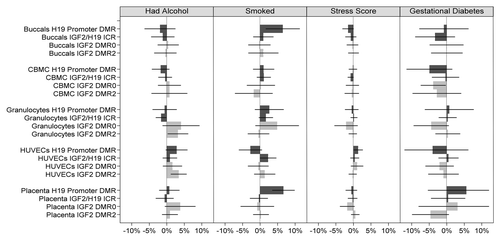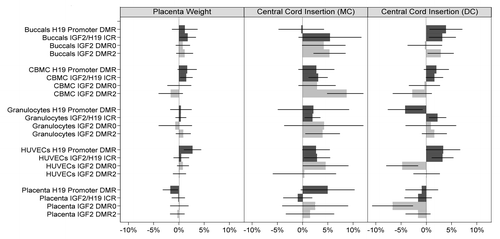Figures & data
Figure 1. Structure of the IGF2/H19 locus with DMRs. The IGF2/H19 locus is shown with direction of transcription, exon locations (gray boxes) and DMRs (white boxes). DMRs assayed for DNA methylation in this study are indicated in bold.

Table 1. Subject characteristics of twin pairs
Table 2. Linear regression of IGF2/H19 methylation jointly on maternal and supply line factors over all five cell types combined
Figure 2. Association of IGF2/H19 methylation and nutrition factors across all cell types and DMRs. Light gray bars represent methylation changes in the IGF2 DMRs, and the dark gray bars represent changes in H19 DMRs. 95% confidence intervals of the coefficient change are represented by a horizontal black line through each bar. The mean methylation differences corresponding to serum vitamin B12, serum homocysteine, and macronutrient are for a 1 standard deviation increase in the respective factor’s z-score. Macronutrient score is obtained as the average of protein, carbohydrate and energy z-scores.

Figure 3. Association of IGF2/H19 methylation and lifestyle factors across all cell types and DMRs. Legend as for . The mean methylation difference corresponding to stress is for a 1 standard deviation increase in the stress z-scores.

Figure 4. Association of IGF2/H19 methylation and supply line factors across all cell types and DMRs. Legend as for . Mean methylation differences are regression coefficients obtained from multivariable regression analysis, whereby regression coefficients are converted to percentage difference by multiplying each regression coefficient with average standard deviation. The mean methylation corresponding to placenta weight is for a 1 standard deviation increase in placenta weight z-score.
